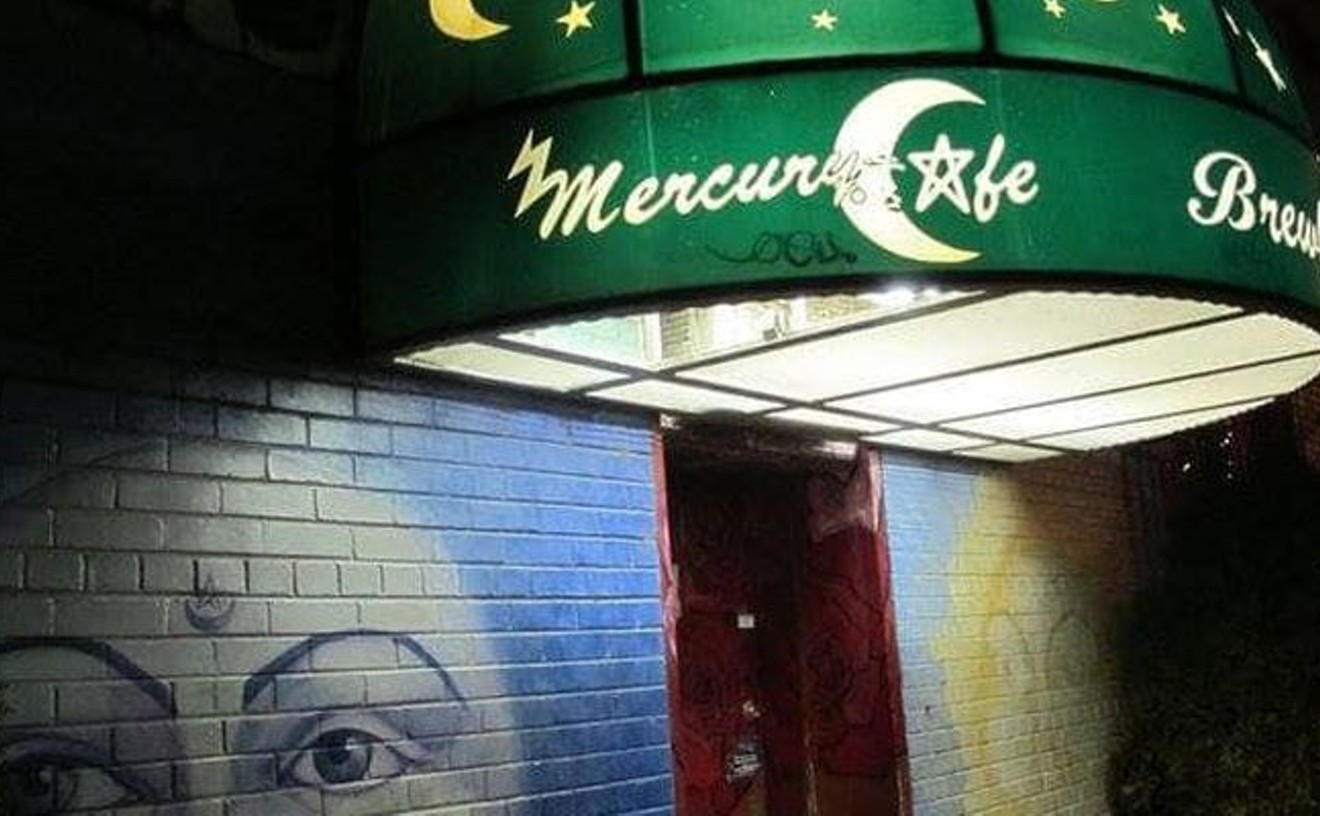While Crane is pleased with the remodeling work and particularly happy to have had her place thoroughly cleaned, she's hardly begun. She wants more than nice rooms in a grungy art building: She wants a proper museum constructed somewhere on the Boulder campus. Given her background, Crane's ambitious plans are no surprise; she came to CU from Atlanta's High Museum, having previously worked at the Walker in Minneapolis and the Albright-Knox in Buffalo. CU chancellor Richard Byyny and Arts and Sciences dean Peter Spear have already bought into her idea, which calls for the museum to be built as an element of new and badly needed studio facilities, with "a separate presence from the exterior," Crane says. Visionary architect Antoine Predock is working on the initial planning phase in conjunction with RNL, a Denver-based architectural firm.
But where on the crowded campus could such a facility be built? "There are a hundred possibilities," says Crane, unconvincingly. Fortunately, one of them is not Grandview Terrace, so preservationists can breathe a sigh of relief. That historic neighborhood just north of campus, a delightful assortment of residences from the early twentieth century that was long ago dubbed "faculty row," is the subject of an ongoing threat from wrongheaded university planners who want to demolish most of the area for campus expansion. But not for a combination museum/studio space---a more likely spot for that is on top of the Euclid Street subterranean parking structure near the University Memorial Center and just off Broadway, a location that would encourage non-campus visitors. "The parking lot was built so that a building could be constructed over it," notes Crane.
The soonest the museum could be up and running is "2006 to 2007," she says, "if everything goes according to plan--which it never does." So in the meantime, Crane will have to make do with the freshly scrubbed CU Galleries, which are hosting two exhibits that inaugurate the new look and also highlight CU's mammoth print collection. Even so, many of these prints have not seen the spotlight of day for decades, if ever.
Under the direction of art historian and now-retired professor John Hoag, CU had long collected prints--but it attained its current premier position among Colorado institutional collectors by default. The Denver Art Museum's print collection once rivaled CU's, but over the last few years the DAM has been foolishly deaccessioning its holdings in the medium; plans call for dumping still more in the very near future. CU, however, is enlarging its collection, already "the largest and most important collection of prints in the state," says Crane. "I like the intimacy of works on paper, including prints." (Prints also have a certain economic appeal, since an entire collection can be put together for what otherwise would buy a single painting.)
The first of Crane's two print shows, Mark Makers: Painterly Abstraction From the Colorado Collection, fills the entry gallery. It's a small but smart display featuring modern and contemporary prints by some of the biggest names in the business. Many of these prints are abstract-expressionist, and if the concept weren't so familiar, it would seem oxymoronic: Abstract-expressionist style is reliant on spontaneity, whereas by definition, printmaking is about careful replication. Still, you can't argue with results this good.
Just inside the entrance are a pair of Robert Motherwells: a diminutive etching, "Untitled (AFA 131)," done in 1966, and "Pauliac #2," a larger vertical piece from the 1973 "Summer Light Series" that uses collage, lithography and screen printing (among other techniques). The etching is like a Rorschach test inkblot marking one extreme in Motherwell's approach; "Pauliac," with its hard-edged, constructivist character, reveals the opposite tendency.
Near the Motherwells is "Lot's Wife," a three-part, vertically stacked color lithograph from 1971 by the late artist's onetime wife, Helen Frankenthaler. Never literal, Frankenthaler merely suggests what became of Lot's wife--she was turned into a pillar of salt--by leaving the center of the three connected sheets blank. Another classic example of abstract-expressionist style is "Mercury," a Sam Francis lithograph from 1963. Totally avoiding both literal and figural elements, Francis suggests the mythical figure of the title through gestural lines and horizontal and diagonal forms.
More than abstract expressionism is on display here, however. Frank Stella's "Swan Engraving Blue," from 1983, is characteristic of his work during that period. Within a sky-blue border, Stella sets a jumble of jagged shapes, mostly in black on white but with elements done in blue. The print combines a wide array of techniques: engraving, of course, as well as etching and woodcut. There's also a representative Sean Scully, "Standing II," a 1986 woodcut in which thick brown horizontal lines are massed above black and gray vertical bars. The heavy saturation of the inks is quite effective and gives the print the look of watercolor.
Only a couple of the prints in Mark Makers include recognizable images. Elizabeth Murray's "Snake Cup," a color lithograph from 1984, depicts an abstracted cup and saucer with a snake-like form wrapped around the rim. "Kimono Still Life Vase," a 1992 woodcut and monotype by former Boulderite and CU art professor Betty Woodman, is just what the title suggests: a still life of a vase, although Woodman has taken pains to disguise her subject through simplification and abstraction.
Nearly every piece in Mark Makers was a gift to CU from well-known Colorado collectors Mark and Polly Addison. The only exceptions are two Larry Poons silkscreens, donated by New York collectors Phyllis and Aron Katz. The substantial donations from this pair of generous couples reveal the key role private collectors play in creating public collections like CU's. Not only do such collectors donate the art itself, but they also pass on their vision.
It's the Katzes' vision that predominates in the second, much grander show, Pop! Selections From the Colorado Collection, which occupies the capacious set of rooms in the back of the CU Galleries. Whereas the prints in Mark Makers are contemplative, in Pop! they're downright bombastic. Thanks to the Katzes and, to a lesser extent, the Addisons, the depth of CU's pop-art holdings is remarkable. Pop! stars a roster of famous artists from the mainstream New York school as well as West Coast players and even some Brits; their work offers a look at both the '60s pop art movement and its heirs.
Although his onetime partner, Jasper Johns, is nowhere to be found in Pop! (perhaps his works are too expensive), the Colorado Collection does contain several pieces by pop pioneer Robert Rauschenberg. Particularly striking are the set of six photo-silkscreen and collage prints from the 1977 "Chow" series, among the few items in either show that have been exhibited before. The subjects of all the "Chow" prints are torn bags of Purina animal food, for creatures as ordinary as domesticated hogs to more extraordinary ones, like monkeys.
Pop! also displays Robert Indiana's entire "The Folder Five" series. Each of these five silkscreens features a five-pointed star in a circle where various mottos are inscribed: "American Dream" in the center, surrounded by "Eat," "Die," "Err" and "Hug." This famous suite refers back to the work of Charles Demuth, whose seminal 1928 painting "I Saw the Number Five in Gold" anticipated the pop art movement by decades. Indiana appropriates Demuth's chosen numeral five (itself inspired by a period William Carlos Williams poem) line for line.
James Rosenquist's "Horseblinders" of 1968-69 is another series seen in its entirety. Each print is subtitled according to the four cardinal directions; for example, in "Horseblinders (East)," Rosenquist, a former billboard painter, places a super graphic rendition of a paintbrush on top of a gray and red backdrop. This series is one of the real standouts in Pop!, deserving of its prominent space at the start of the exhibit.
More typical than these complete suites, though, are the individual works in Pop! Two Roy Lichtenstein prints offer markedly different approaches and technique. "Untitled," from 1973, is classic Lichtenstein, a blurring of the distinction between popular culture and fine art that gained the artist international fame during his lifetime. In this cartoon version of a man's hand, a pointed finger, colored naturalistically, is aimed directly at the viewer against a fiery red ground. "Two Paintings: Painting in a Gold Frame," a 1984 print combining a variety of techniques, represents a later Lichtenstein phase, when his subject was the nature of art itself. The bottom and left side of the print provide a glimpse of a cartoon sketch of a frame; the painting within the frame is an abstract-expressionist one. With irony and wit, Lichtenstein conveys the gestural paint-laden brush strokes of abstract expressionism in the flat manner of a commercial illustration. In so doing, he subverts the established concepts of abstract painting.
Also interested in subversion was the legendary Andy Warhol. Unfortunately, the two Warhol prints in Pop! mark a low point in the artist's career, when he turned to portraits such as the drag queens seen in the pair of "Ladies and Gentlemen" silkscreens from 1975. What at first glance appears to be a fabulous early Warhol, one of his significant "Brillo Box" prints, is actually a postmodern spoof, a 1991 silkscreen by Mike Bidlo titled "This Is Not a Warhol." With that title, Bidlo refers to both pop guru Warhol and surrealist master Rene Magritte, who made a career of this kind of deadpan humor.
Crane's intelligent choices for Mark Makers and Pop!--not to mention the insight and generosity of the Addisons and Katzes that made her choices possible--provide viewers not just a valuable lesson in the recent past of prints, but a glimpse at the bright future of the revived CU Galleries.
Mark Makers: Painterly Abstraction From the Colorado Collection and Pop! Selections From the Colorado Collection, through March 20 at the CU Art Galleries in the Sibell-Wolle Fine Arts Building on the Boulder campus, 303-492-8300.










